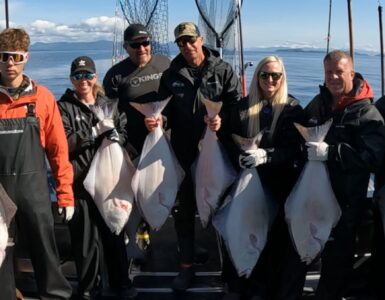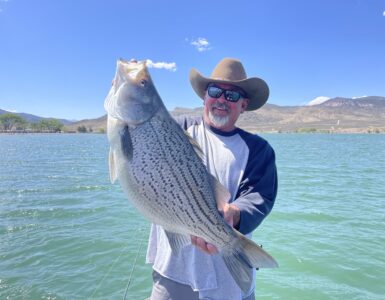(Adam intro) Thanks for tuning into KSL Outdoors, I’m Adam Eakle and welcome to beautiful Starvation Reservoir. Pete and Ben from Sportsman’s Warehouse in Midvale called me and said ‘hey let’s go to Starvation and catch the Starvation Slam. I said sure, but what is that?
(Pete Milburn, Sportsman’s Warehouse) The Starvation slam is you catch walleye, perch, smallmouth, and of course rainbow trout and hopefully a brown trout all in the same day and that’s what we are going to try and do today, pull off a grand, starvation slam.
Starvation has been on the radar of many fisherman lately. Not only is there good bass, walleye and perch fishing, but the last couple of years Starvation has been gaining a reputation as a great rainbow fishery. Tonight, we’re going to show you some good fishing, but our goal is to give you some tips and techniques from some of the best fisherman in the state to help you come out and catch some fish.
(pete Milburn) (adam) you brought a cooler for your worms? (Pete Milburn) you bet, I like to keep my worms nice and insulated. (adam) what is that? (pete) it’s my Fraybill, worm and leech container. What I’ve done is I’ve froze the bottom of it. I filled it up with water and froze it. It’s got two compartments in it. I froze the bottom of it, then I put ice water in the top, rinsed the worms off.
(Pete) and then you throw the worms in here, it will keep them fresh and cold all day long, even with this container out in the sun, being insulated, the worms will be perfect. Don’t worry, they won’t drown.
(adam) and you don’t get your boat and your hands all dirty. (pete) that’s right no dirt all over Adam’s pretty little boat.
(Pete) let’s get rigged up shall we.
Tonight we want to show you a popular technique for targeting walleye. It’s often called spinner rigging or bottom bouncing. Brad Cutler is one of the most knowledgeable walleye anglers in the state.
(Brad Cutler, Rocky Mountain Anglers) equipment is one of the keys for spinner rigging and bottom bouncing for walleye. One thing that is really helpful is to get a real with a flipping switch on it. What the flipping switch does is it allows you to push down, you can let the line out that you need to adjust, lift your thumb and it automatically locks you in the right depth that you need to be at.
(Brad) I like to use a two ounce bottom bouncer with generally a size 4 Indiana or Colorado blade, that’s a good thing, that’s what I normally start with and a two hook rig like this.
(Brad) the first thing you’ve got to do is hook your nightcrawler on properly.
(Brad) What you want to do is when you hook your crawler on your spinner rig, is you hook it through the front hook, stretch your crawler out and then hook it through the back hook like so, it runs straight.
(Brad) The most important thing in my mind is how much line you have out, it’s very critical. If you let too much line out, your bottom bouncer goes down and it drags on the side. So you want to have it so it’s just barely ticking the bottom as you go across here. The next thing is when you are hooking a fish, when you get a bite. You’ll be going across, feel a bite, what you want to do is drop your rod tip back until you’ve got it tight again and you feel the fish and then you sweep it straight forward like that. You don’t jerk it… and that will set the hook in them.
(ADAM) What have you got? (pete) feels like a rainbow. (adam) feels like a rainbow, but were bottom bouncing for walleye. (pete) well sometimes you can bottom bounce for rainbows. (pete) big ones! Starvation steelhead. (adam) that’s a pretty one. Look at that he’s tail walking. (adam) nice fish, dang they are thick.
I’ve caught every species of fish at Stravation using the bottom bouncing technique. If you’ve never experienced these hard fighting rainbows, here, you’d better get out and try them. They’re a lot of fun for kids of all ages.
(Pete) oh look at that, she’s a sow. Oh…don’t break her off.
Coming up, we show the progress the DWR has made with their urban goose project, but first let’s find out a little history on starvation as we check out tonight quiz question.
***********************************************************
(Tonya Kieffer, UDWR/KSL Outdoors Correspondent) Welcome back to KSL Outdoors, I’m Tonya Kieffer. Urban geese tend to be a problem here in the state of Utah. Just so happens we have DWR staff on hand here, right in the middle of Salt Lake City, and we’re getting ready to ” goose” some geese for some relocation.
Urban geese may add aesthetics to local ponds, but that all comes at a cost, and I don’t mean “green” money.
(Kevin Astill, Parks & Rec Director, West Valley City) They do a lot of feeding and so they peck at the greens and the tees and just really make a lot of holes and they put out a lot of waste.
We interviewed local golfers as they were about to tee off, just to see if they had similar experiences, with our neighborhood wildlife.
(Greg Decker, West Valley, local golfer) Well, they can get in the way a little bit. Of course they can leave a lot behind.
Since 2006, urban geese roundups have occurred in the Salt Lake Valley every June when geese are molting their feathers and are unable to fly.
(Rich Hansen, UDWR Farmington Bay Wildlife Management Area Supervisor) Alright, would a few people like to step in there and grab, start grabbing them.
Various methods were used to corral the gaggles of adult geese and their goslings into the holding pens. Once they were caught, volunteers were sent in to test their wrangling skills.
(Blair Stringham, UDWR Waterfowl Program Coordinator) We have several volunteers, as well as our biologists, who go around to different parks in the city and look at the number of geese that we have in every area, and then we put together a schedule of where we can hit the highest densities of geese. We go around and set up traps and push the geese into the traps. We band them and then take them to their new homes.
Herding geese is no easy chore, just ask fellow goose “herders” how hard it is to chase a “land-bound” adult goose.
(Blair Stringham, UDWR Waterfowl Program Coordinator) We’re just doing it to remove all these urban geese that are in town. Just reduce the damage to the golf courses and parks, and also to take the young to other parts of the state to increase hunter opportunity to harvest geese.
(Rich Hansen, UDWR) So the juveniles, will probably go to public shooting grounds, Salt Crick, somewhere like that. And the adults will probably go down to Clear Lake, down by Delta.
(Rich Hansen, UDWR) So we are determining the sex of the geese, and we’re putting leg bands on, so we can determine if they come back. A lot of these adults are banded and we can determine where we banded them last year based on the numbers.
(Rich Hansen, UDWR) Band. 36 Local Female.
(Blair Stringham, UDWR) This has a red leg band on it. What that means is that we caught it about 5 or 6 years ago, and it means he’s a repeat offender, so we’ll take him somewhere so he can’t come back.
(Rich Hansen, UDWR) They can tell us migration patterns, survival rates, mortality rates. From these urban birds that we turn loose, with the wild birds, we are seeing a lot of cool things. We’ve caught over 4,000 young in the city and relocated them into the wild in the last seven years, and through band returns, we’ve determined a lot of these birds go to Alberta, Saskatchewan, Montana, Idaho. We’ve had North Dakota band returns, Kansas, Missouri. So by turning them loose with wild birds, they starting to migrate and do exactly what wild birds do. We’ve only retrapped 30 juveniles back in the city, so it’s been a great success.
Volunteers that assist these biologists have made the project successful. Data collection may be crucial to biologists, but having an up close and personal experience with these wild geese, has left many family and friends, coming back each year.
(Kevin Talbott, CFO Sportsman’s Warehouse) How many kids can say they got a chance to hold a goose.
(Kevin Talbott, CFO Sporstman’s Warehouse) The kids love it. It’s a chance to interact with wildlife in our backyard.
(Kevin Talbott, CFO Sportsman’s Warehouse) We chase them all fall and through the winter to hunt them, but then a chance to come out here and interact and help them out and get them off the golf courses. It’s a great opportunity.
(Tonya Kieffer) The Division of Wildlife Resources will be capturing geese throughout the week, and relocating them to their new home at the Salt Creek Wildlife Management Area, where these little guys will get a new lease on life. And now time to turn it over to the guys at Fish Tech, for tonight’s fishing report.
********************************************************************
(Adam) Welcome back to KSL Outdoors, I’m Adam Eakle. Hey did you know we actually have sharks in Utah, who would have thought. Located just outside the small town of Grantsville are some warm springs and over the years, those warms springs have developed into the Bonneville Sea Base.
(Linda Nelson, Owner, Bonneville Seabase) It’s a lot harder than we ever dreamed it would be to figure out how to make an ocean out of this. (laughs).
What was once, nine small warm springs in the early 90’s has been transformed into three large, geothermally heated, salt water, high altitude, mini ocean bays. The only one of it’s kind in Utah.
(linda) it’s salty, almost as salty as the ocean, not quite.
(Linda Nelson) so we joined the ponds together to make them big enough to move around in and of course cool them down a little bit, they used to be a bit warmer.
Bonneville Seabase is a year round snorkeling and scuba diving facility. It’s open to the public. They provide the gear and the most interesting part…tropical fish.
(Linda) (adam) how many species of fish do you have? (linda) at least 60, now we are not sure who all didn’t make it through the winter or got eaten by the bigger ones, because there is a lot of carnivores in and amongst all of our little fish. The butterfly fish are doing very well. The pork fish are reproducing and going crazy. There is the two sharks and the one stingray. (adam) wait did you say sharks? (linda) two sharks.
(Ron Simmons, Bonneville Seabase) normally the commotion that these fish makes will bring up there shark, there is the shark. We’ll watch and see if he comes over here to feed.
(Ron) he’s ready to eat.
With a steady diet of halibut, tuna and salmon, these two ten foot long nurse sharks are an impressive.
(RON) yup just like that and put it right underneath his nose. His mouth is about where his eyes are.
There’s also, Steve the Stingray.
(stingray eating) he got it, he’ll suck on it.
(Ron) isn’t that kind of cool. (girls) that’s awesome. (ron) that on is Steve, Irwin is gone.
And dozens darting crevalle jacks.
(Linda) the fish are an interesting part of it because it is so much more fun to dive with fish than without.
The water hovers between 65 degrees in the winter to 85 in the summer.
(adam into water) Oh, it takes your breathe away though.
(Richard Parker, Tooele) as long as you stayed pretty still the big fish would come up and play around you. You got to see them. The fish look a lot bigger underwater than they do from here. It was a really good experience.
(Christine Catino, Tooele) I was a little nervous the way they were eating that fish he was throwing in. I was hopping that I didn’t taste like a tuna. (laughs)
(Ron) any and everybody is invited to come out any dive shops. We have all kinds of groups that come out. Like the lady today, she just learned to swim and she’s out snorkling with the fish. We think we have something very unique out here..
(ADAM TAG) wow, that is really cool experience, you see the big fish swimming down below you. The little fish come up and eat off the head of lettuce. A great experience maybe for a scout group. How about a prom date before you head off to the dance, they have those here too. If you want more info you can check them out on their website, we’ll put it right there on the screen (www.seabase.net).
Hey time to get the mask back on and dive into tonights Utah field guide.







Add comment